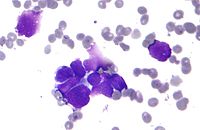
Photo from wikipedia
Hepatitis B virus X protein (HBx) contributes to Hepatitis B virus (HBV)-related liver cancer. However, its impact on hepatocyte proliferation and genomic stability remains elusive. We studied the role of… Click to show full abstract
Hepatitis B virus X protein (HBx) contributes to Hepatitis B virus (HBV)-related liver cancer. However, its impact on hepatocyte proliferation and genomic stability remains elusive. We studied the role of HBx expression on the progression of cell cycle and liver polyploidization during proliferation and liver carcinogenesis. Full-length HBx transgenic mice (FL-HBx) were developed to investigate liver ploidy as well as hepatocyte proliferation, along normal liver maturation and during cancer initiation (chemical carcinogen treatment). Investigation of postnatal liver development in FL-HBx showed an aberrant G1/S and G2/M transitions, triggered (1) a delay of the formation of hepatocytes binucleation, (2) the early synthesis of polyploidy nuclei (≥4n) and (3) DNA damage appearance. Moreover, HBV infection during hepatocytes proliferation in a humanized liver mouse model led, to modifications in polyploidy of hepatocytes. In initiation of hepatocellular carcinoma, FL-HBx protein decreased ChK1 phosphorylation, Mre11 and Rad51 expression, upregulated IL-6 expression and impaired apoptosis. This was related to DNA damage accumulation in FL-HBx mice. At day 75 after initiation of hepatocellular carcinoma, FL-HBx mice revealed significant cell cycle changes related to the increased amount of 4n nuclei and of markers of cancer progenitor cells. Finally, PLK1 upregulation and p38/ERK activation in FL-HBx mice were implicated in aberrant polyploidization favoring DNA damage propagation and hepatocyte transformation. In conclusion, our data indicate that FL-HBx protein increases DNA damage through the hijack of hepatocyte polyploidization. That leads to enhancement of hepatocellular carcinoma initiation in an inflammatory context.
Journal Title: Oncogene
Year Published: 2018
Link to full text (if available)
Share on Social Media: Sign Up to like & get
recommendations!